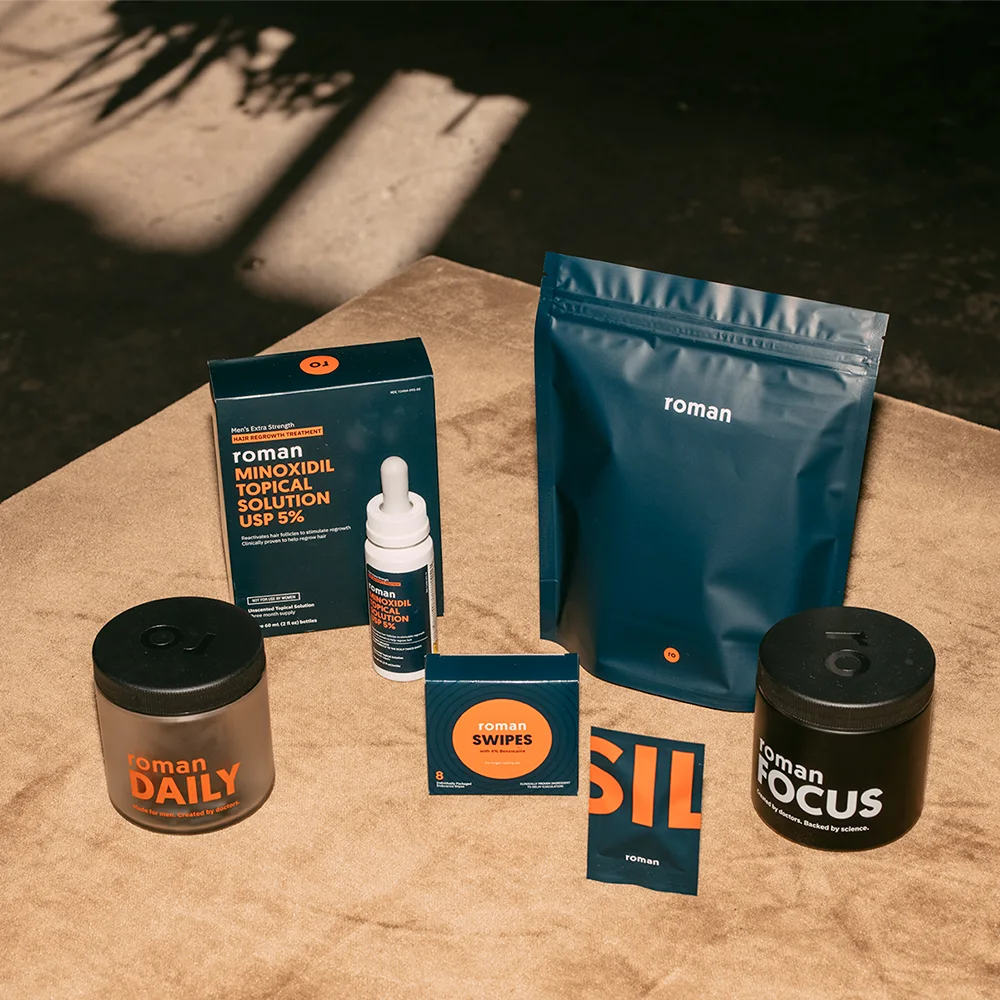Here's what we'll cover
Here's what we'll cover
If you notice pain in your left testicle, you may wonder if that pain means you have testicular cancer. Though cancer can lead to pain in your testicles, cancer down there is pretty rare, and there are many other more common reasons for why you have left testicle pain.
Even though cancer is unlikely, it’s still important to pay attention to pain. There are various medical conditions that a healthcare provider needs to address if you have pain in your left testicle.
What causes left testicle pain?
The scrotum has a lot of nerves, which helps explain why so many men experience testicular pain. The testicles sit inside the scrotum. Because of all the nerves, even a minor injury or condition can cause pain (Velasquez-a, 2021).
Testicular pain can be a dull ache or sharp pain, acute (short-term) or chronic (long-term), and it may be constant or come and go. A majority of the causes of testicular pain can trigger pain in either testicle or both at the same time. However, two conditions typically cause left testicle pain when they occur:
Varicoceles
Varicoceles are veins in the scrotum that can twist and enlarge—resembling what’s sometimes called a “bag of worms.” Often they don’t cause symptoms but can get worse and lead to pain. Problems with blood flow can lead to these enlarged veins (Leslie-a, 2021).
Aside from potentially causing pain, varicoceles are the most commonly identified cause of low sperm count and have a link to infertility. The heat from extra blood in the area is thought to damage sperm. Removing the varicoceles has been shown to improve fertility (Kupis, 2015).
Right-sided varicoceles are not as common and could be a sign of abnormal vein anatomy, a hernia in the groin, or a tumor. It’s best to check with your healthcare provider to determine the causes of enlarged veins on the right side (Gleason, 2018).
Testicular torsion
Testicular torsion, also known as a twisted testicle, is a medical emergency. It happens when the spermatic cord, which has ducts and blood vessels, is twisted and begins to cut off blood flow to the scrotum. This usually causes sudden, severe pain, swelling, and can lead to nausea, vomiting, and increased urination (Hyun, 2018; Schick, 2021).
This is an emergency because a lack of blood can cause tissue to die. After six hours, there is a risk of losing the testicle. A medical professional may be able to untwist it without surgery, but often, surgery is necessary. While it’s more common in ages 12-16, testicular torsion can happen at any age (Hyun, 2018).
Other causes of pain in the left testicle
Most conditions can cause pain in either testicle. Here are additional, common conditions that may cause left testicular pain:
Trauma: Trauma to the testicle often causes intense pain, followed by a dull aching pain. If the pain continues or the scrotum begins to swell, it’s best to seek medical attention in case there is testicular torsion or testicular rupture (Randhawa, 2019).
Hematocele: After a traumatic injury or surgery, there’s a chance blood build-up around the testicle can turn into a hematocele, a pooling of blood in the scrotum that can be painful. A hematocele often goes away without treatment, but it can lead to small calcifications, which feel like small bumps or larger masses (Garcia, 2021).
Epididymitis: Epididymitis is the most common cause of scrotal pain in adults and is the inflammation of the tube in the back of the testicle (epididymis) that stores sperm. When it becomes swollen, it can cause pain in the testicle (Rupp, 2021).
Epididymo-Orchitis: If epididymitis is not treated soon enough, it can lead to orchitis, the inflammation of testicles. Epididymo-orchitis combines both types of inflammation (epididymis and testicles) and is caused by bacterial or viral infections—usually STIs or urinary tract infections. In cases of massive infection, it can affect fertility and require surgical intervention (Azmat, 2021; Banyra, 2012).
Spermatoceles and hydroceles: A spermatocele is a cyst filled with clear or cloudy fluid that may contain sperm that may form in the epididymis. A hydrocele is a buildup of fluid around the testicle. They are not cancerous and usually don’t cause pain, but they can. If they grow, the added pressure can cause pain, heaviness, or discomfort. Some can grow as large as a testicle, and men choose to remove them (Huzaifa, 2021; Walsh, 2007).
Testicular cancer: While an unlikely reason for your testicular pain, if left untreated, a testicular cancer tumor can grow and cause pain. Usually, the affected testicle is removed through the groin during a minimally invasive surgery called a radical inguinal orchiectomy (Vaz, 2019; Batool, 2019).
Referred pain: There are several conditions that cause pain to radiate to the testicles, including inguinal hernias, kidney stones, pinched nerves, backaches, neuropathy, aortic aneurysm, and hip pain (Patel, 2017).
When to call the doctor
Some conditions, like testicular torsion, require immediate medical care. Others may require a visit to a urologist. Healthcare providers suggest you seek immediate medical attention if you experience any of the following in the scrotum (Velasquez-b, 2021):
Sudden or severe pain
Inability to locate both testicles
Pain or swelling more than an hour after an injury
Pain with nausea or vomiting
Pain and fever (101 Fahrenheit or greater)
Scrotum that is painful, feels warm, and is red
Difficulty urinating
Feeling the need to urinate but aren’t producing urine
Blood or discharge in urine
Pain that is getting worse
Diagnosing and treating left testicle pain
If the pain in your left testicle appears to be an emergency, a trip to an emergency room may be in order. If an office visit will work, your healthcare provider may refer you to a urologist.
In either scenario, a medical professional will conduct a physical exam of the area and gather a personal history. They will likely use a Doppler ultrasound to image the area. Depending on the initial assessment, other tests may involve blood counts and urine tests, including tests for STIs. (Velasquez-b, 2021).
Once your healthcare provider determines the cause of your left testicle pain, they can recommend a course of treatment. Bacterial infections require antibiotics. Serious injuries, tumors, and conditions that involve nerve pain may require surgery. Surgeries range from minimally invasive procedures to remove veins to more invasive surgeries such as the removal of tumors and cysts. An over-the-counter pain reliever like ibuprofen can help with mild pain. To treat chronic pain, there are nerve blocks and the option of permanently removing nerves (Leslie-b, 2021).
After some treatments, you may need to avoid heavy lifting. A urologist may also suggest physical therapy or exercises designed to reduce pelvic floor pain (Farrell, 2016). Different conditions will require different post-treatment protocols, and your healthcare provider will provide you with a list of ways to alleviate pain at home following treatment.
Feeling pain in your left testicle can be jarring, but remember, it’s likely not cancer. If your pain is severe, head to your local emergency department. If it is not emergent, make an appointment with your healthcare provider so that they can more accurately assess, diagnose, and treat the cause of your pain.
DISCLAIMER
If you have any medical questions or concerns, please talk to your healthcare provider. The articles on Health Guide are underpinned by peer-reviewed research and information drawn from medical societies and governmental agencies. However, they are not a substitute for professional medical advice, diagnosis, or treatment.
Azmat, C. E. (2021, July 3). Orchitis . StatPearls [Internet]. Retrieved October 8, 2021, from https://www.ncbi.nlm.nih.gov/books/NBK553165/ .
Banyra, O., & Shulyak, A. (2012). Urinary tract infection acute epididymo-orchitis: Staging and treatment. Central European Journal of Urology , 65 , 139–143. doi:10.5173/ceju.2012.03.art8. Retrieved from https://www.ncbi.nlm.nih.gov/pmc/articles/PMC3921787/
Batool, A., Karimi, N., Wu, X.-N., Chen, S.-R., & Liu, Y.-X. (2019). Testicular germ cell tumor: A comprehensive review. Cellular and Molecular Life Sciences , 76 (9), 1713–1727. doi:10.1007/s00018-019-03022-7. Retrieved from https://pubmed.ncbi.nlm.nih.gov/30671589/
Bowdino, C. S. (2021, May 17). Anatomy, abdomen and pelvis, renal veins . StatPearls [Internet]. Retrieved October 8, 2021, from https://www.ncbi.nlm.nih.gov/books/NBK538298/ .
Garcia, R. A. (2021, July 31). Anatomy, abdomen and pelvis, scrotum . StatPearls [Internet]. Retrieved October 8, 2021, from https://www.ncbi.nlm.nih.gov/books/NBK549893/# .
Gleason, A., Bishop, K., Xi, Y., & Fetzer, D. T. (2019). Isolated right-sided varicocele: Is further workup necessary? American Journal of Roentgenology , 212 (4), 802–807. doi:10.2214/ajr.18.20077. Retrieved from https://www.ajronline.org/doi/10.2214/AJR.18.20077
Huzaifa, M. (2021, July 12). Hydrocele . StatPearls [Internet]. Retrieved October 8, 2021, from https://www.ncbi.nlm.nih.gov/books/NBK559125/ .
Hyun, G. S. (2018). Testicular torsion . Reviews in urology. Retrieved October 8, 2021, from https://www.ncbi.nlm.nih.gov/pmc/articles/PMC6168322/ .
Kupis, L., Artur Dobronski, P., & Radziszewski, P. (2015). Varicocele as a source of male infertility – current treatment techniques. Central European Journal of Urology , 68 (3). doi:10.5173/ceju.2015.642. Retrieved from https://www.ncbi.nlm.nih.gov/pmc/articles/PMC4643713/
Farrell, M. (n.d.). Physical therapy for chronic scrotal content pain with associated pelvic floor pain on digital rectal exam . The Canadian journal of urology. Retrieved October 8, 2021, from https://pubmed.ncbi.nlm.nih.gov/27995849/ .
Leslie-a, S. W. (2021, August 12). Varicocele . StatPearls [Internet]. Retrieved October 8, 2021, from https://www.ncbi.nlm.nih.gov/books/NBK448113/# .
Leslie-b, S. W. (2021, August 12). Chronic testicular pain and orchalgia . StatPearls [Internet]. Retrieved October 8, 2021, from https://www.ncbi.nlm.nih.gov/books/NBK482481/ .
Levine, L. A., & Tan, W. P. (2016). An overview of the management of post-vasectomy pain syndrome. Asian Journal of Andrology , 18 (3), 332. doi:10.4103/1008-682x.175090. Retrieved from https://www.ncbi.nlm.nih.gov/pmc/articles/PMC4854072/
Orczyk K;Łabetowicz P;Lodziński S;Stefańczyk L;Topol M;Polguj M; (n.d.). The Nutcracker Syndrome. morphology and clinical aspects of the important vascular variations: A systematic study of 112 cases . International angiology : a journal of the International Union of Angiology. Retrieved October 8, 2021, from https://pubmed.ncbi.nlm.nih.gov/25972135/ .
Patel, A. P. (2017). Anatomy and physiology of chronic scrotal pain. Translational Andrology and Urology , 6 (S1). doi:10.21037/tau.2017.05.32. Retrieved from https://www.ncbi.nlm.nih.gov/pmc/articles/PMC5503924/
Randhawa, H., Blankstein, U., & Davies, T. (2019). Scrotal trauma: A case report and review of the literature. Canadian Urological Association Journal , 13 (6S4). doi:10.5489/cuaj.5981. Retrieved from https://www.ncbi.nlm.nih.gov/pmc/articles/PMC6565400/
Rupp, T. J. (2021, August 12). Epididymitis . StatPearls [Internet]. Retrieved October 8, 2021, from https://www.ncbi.nlm.nih.gov/books/NBK430814/ .
Schick, M. A. (2021, August 2). Testicular torsion . StatPearls [Internet]. Retrieved October 8, 2021, from https://www.ncbi.nlm.nih.gov/books/NBK448199/ .
Vaz, R. M., Bordenali, G., & Bibancos, M. (2019). Testicular cancer—surgical treatment. Frontiers in Endocrinology , 10 . doi:10.3389/fendo.2019.00308. Retrieved from https://www.ncbi.nlm.nih.gov/pmc/articles/PMC6529845/
Velasquez-a, J. (2021, July 18). Acute Scrotum pain . StatPearls [Internet]. Retrieved October 8, 2021, from https://www.ncbi.nlm.nih.gov/books/NBK470335/# .
Velasquez-b, J. (2021, July 18). Acute scrotum pain (nursing) . StatPearls [Internet]. Retrieved October 8, 2021, from https://www.ncbi.nlm.nih.gov/books/NBK568680/# .
Walsh, T. J., Seeger, K. T., & Turek, P. J. (2007). Spermatoceles in adults: When does size matter? Archives of Andrology , 53 (6), 345–348. doi:10.1080/01485010701730690. Retrieved from https://pubmed.ncbi.nlm.nih.gov/18357964/










